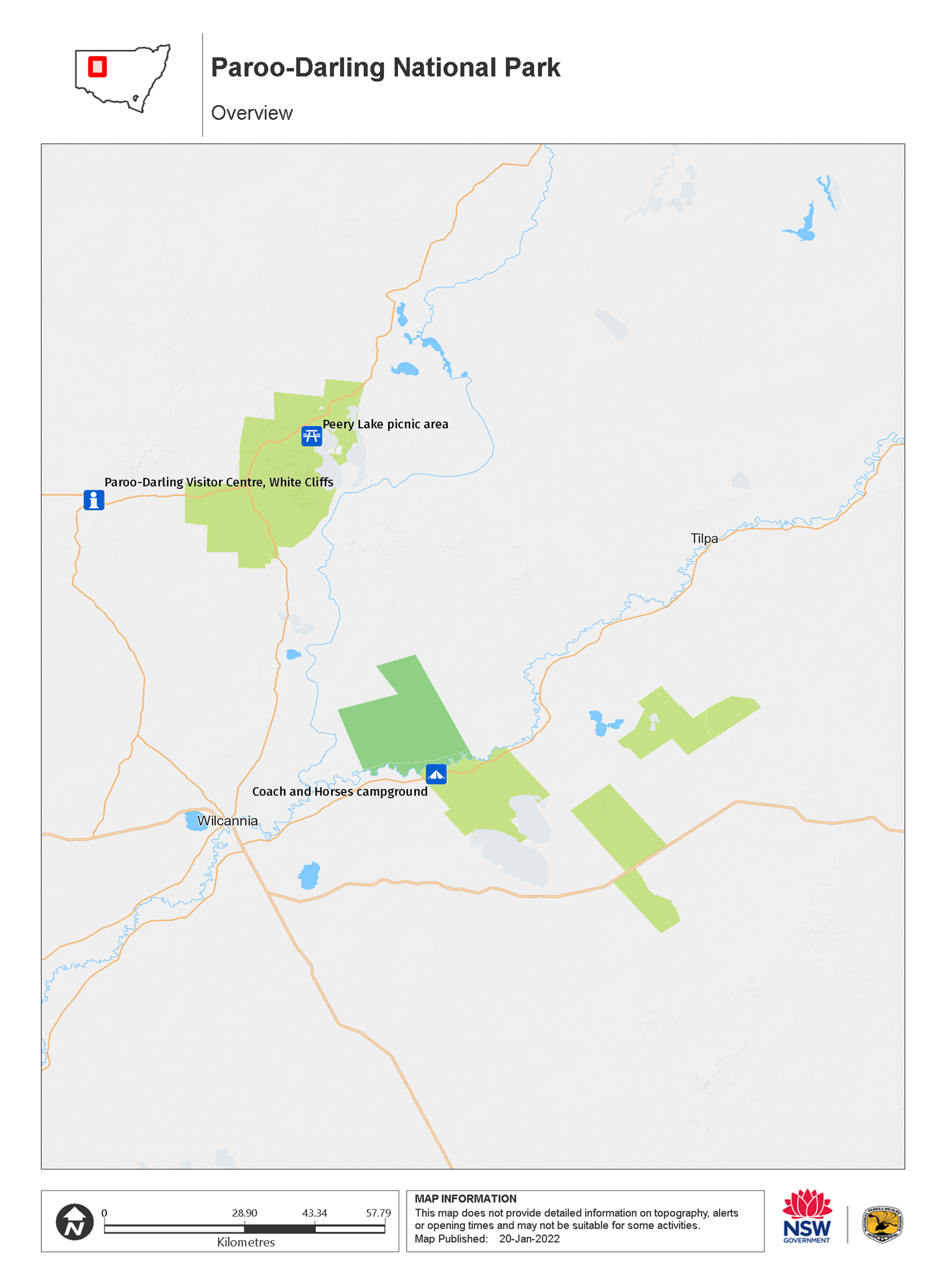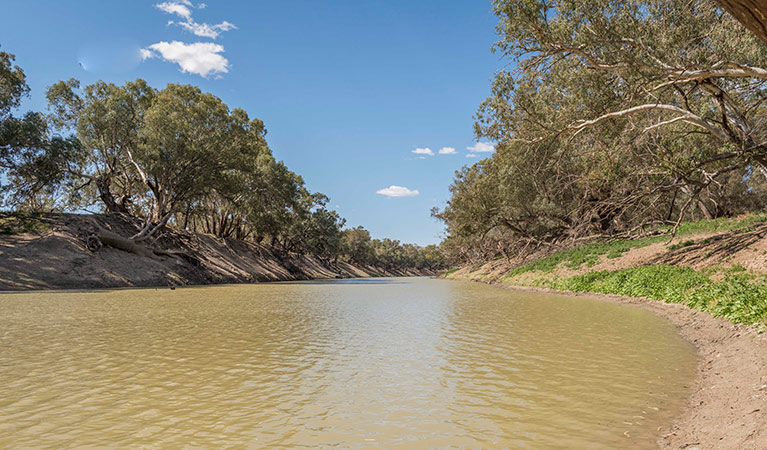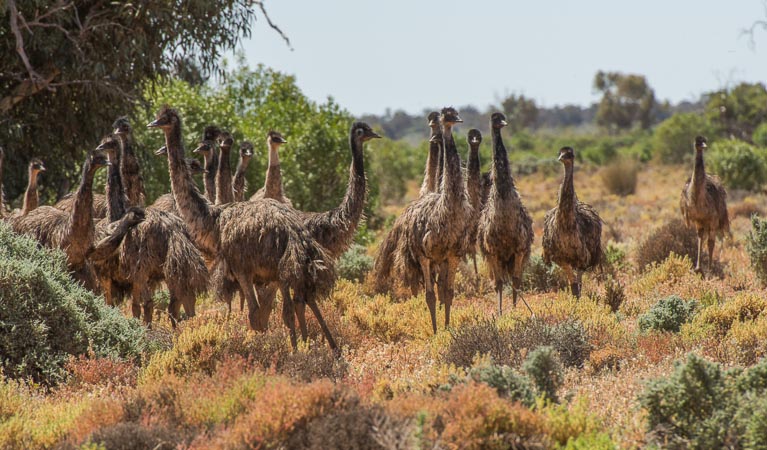Paroo-Darling National Park
Open, check current alerts
Overview
Discover Paroo-Darling National Park's rich history on a school excursion or camping trip to explore the Murray-Darling Basin. Enjoy kayaking, canoeing, fishing and picnicking opportunities.
Read more about Paroo-Darling National Park
At Paroo-Darling National Park, you’ll find the Paroo Overflow, the only unregulated river in the Murray-Darling Basin and an area of outstanding conservation value and natural beauty.
Spend a couple of days exploring the park - paddle or walk around Peery Lake, you'll be amazed by the birdlife - 60,000 birds were recorded in a recent survey. There are heaps of informal spots for a picnic - choose your own scenic place - and camping is available at Coach and Horse campground in the Wilga section of the park. Be sure to bring your fishing rod along to this popular fishing spot.
With its frequent floods, this area is also the traditional home to the Ngiyeempaa and Paakantyi people and since European settlement has been an important pastoral area. The area’s rich history is waiting for you to discover.
Local alerts
For the latest updates on fires, closures and other alerts in this area, see https://www.nationalparks.nsw.gov.au/visit-a-park/parks/paroo-darling-national-park/local-alerts
Map

Map legend

Contact
- in the Outback NSW region
Paroo-Darling National Park is always open but may have to close at times due to extreme weather or fire danger.
-
-
Broken Hill office
08 8084 2880
Contact hours: Monday to Friday, 8.30am to 4.30pm. Closed 1pm to 2pm. - 183 Argent Street, Broken Hill NSW 2880
-
Email: npws.westdarling@environment.nsw.gov.au
-
Broken Hill office
-
-
Paroo-Darling Visitor Centre, White Cliffs
Contact hours: Monday to Friday, 8.30am to 4.30pm. - 2 Johnston Street, White Cliffs NSW 2836
-
Email: npws.westdarling@environment.nsw.gov.au
-
Paroo-Darling Visitor Centre, White Cliffs
Visitor info
All the practical information you need to know about Paroo-Darling National Park.
Getting there and parking
Get driving directions
To get to the Peery section of Paroo-Darling National Park:
- From the Barrier Highway at Wilcannia:
- Travel north along the sealed road to White Cliffs (90km)
- Then travel east along the unsealed Mandalay Road (20km)
- Or from Wilcannia, travel north up the unsealed Wanaaring Road (80km)
To get to the Wilga section of Paroo-Darling National Park:
- From Wilcannia travel east along the Barrier Highway to the Tilpa Road turn off (5km)
- Then travel north east along the unsealed East Tilpa Road (35km)
Parking
- Paroo-Darling Visitor Centre, White Cliffs See on map
- Peery Lake picnic area See on map
Road quality
- Unsealed roads
Vehicle access
- 2WD vehicles
Weather restrictions
- Dry weather only
By bike
Check out the Bicycle information for NSW website for more information.
Best times to visit
It's a haven for waterbirds, so the best time of year to visit is when Peery Lake is full. Spring is a good time to see emu chicks and at other times you may see kangeroos, eagles and falcons.
Weather, temperature and rainfall
Summer temperature
Average
23°C and 36°C
Highest recorded
48.6°C
Winter temperature
Average
5°C and 19°C
Lowest recorded
-3.3°C
Rainfall
Wettest month
January
Driest month
September
The area’s highest recorded rainfall in one day
173.2mm
Facilities
Toilets
Picnic tables
Barbecue facilities
Maps and downloads
Prohibited
Pets
Pets and domestic animals (other than certified assistance animals) are not permitted. Find out which regional parks allow dog walking and see the pets in parks policy for more information.
Smoking
NSW national parks are no smoking areas.
Visitor centre
-
Paroo-Darling Visitor Centre, White Cliffs
2 Johnston Street, White Cliffs NSW 2836 - Monday to Friday, 8.30am to 4.30pm.
Nearby towns
White Cliffs (73 km)
Opals were discovered in the White Cliffs area as early as 1884. The town's first store and hotel opened in 1892, and miners soon arrived to dig their fortunes out of the ground. Make sure you buy an opal keepsake from one of the world's most unusual towns.
Wilcannia (167 km)
The small historic town of Wilcannia is located on the famous Darling River in the NSW outback. The nearby remote Mutawintji National Park offers a uniquely Australian experience, with its historic Aboriginal sites and captivating rugged desert terrain.
Broken Hill (360 km)
About 10 km from Broken Hill, in the middle of the Living Desert Reserve, is Sundown Hill, the site of the Living Desert Sculptures. Follow the easy walking trail that takes you past these beautiful sandstone sculptures, even more striking in this desert setting.
Learn more
Paroo-Darling National Park is a special place. Here are just some of the reasons why:
European history

Pastoralists were also attracted to the banks of the Darling River. As well as water, it provided a major transport corridor. Riverboats began navigating the system in the 1850s, and Cobb and Co also ran several routes through this important pastoral region.
- Darling River Run tag-along tour Follow the Darling River on a 15-day driving trip with Xpedition Tagalong Tours. Explore the incredible attractions in Outback NSW as you journey from Lightning Ridge through Broken Hill to Wentworth.
Aboriginal heritage

The Paakantyi and Ngiyeempaa People have traditionally made this area their home. The park is a historically and culturally important site: with its hearths, quarries and specialised microblade occupation sites, the area provides significant information about changing technologies and ways of life over the last 10,000 years.
A unique and diverse ecosystem

The Paroo Overflow and its associated wetlands sustain a unique ecosystem, including such threatened species as the freckled duck and blue-billed duck. You may also see black-breasted buzzards, pink cockatoos, pied honeyeaters and any one of 55 bird species that visit the lakes. Peery Lake, a major part of the system, is part of an internationally significant wetland and protected under the Ramsar Convention.
Plants and animals protected in this park
Animals
-

Wedge-tailed eagle (Aquila audax)
With a wingspan of up to 2.5m, the wedge-tailed eagle is Australia’s largest bird of prey. These Australian animals are found in woodlands across NSW, and have the ability to soar to heights of over 2km. If you’re bird watching, look out for the distinctive diamond-shaped tail of the eagle.
-

Emu (Dromaius novaehollandiae)
The largest of Australian birds, the emu stands up to 2m high and is the second largest bird in the world, after the ostrich. Emus live in pairs or family groups. The male emu incubates and rears the young, which will stay with the adult emus for up to 2 years.
-

Red kangaroo (Macropus rufus)
The red kangaroo is one of the most iconic Australian animals and the largest marsupial in the world. Large males have reddish fur and can reach a height of 2m, while females are considerably smaller and have blue-grey fur. Red kangaroos are herbivores and mainly eat grass.
Plants
-

Mulga (Acacia aneura)
Mulga are hardy Australian native plants found throughout inland Australia. With an unusually long tap root, the mulga is able to withstand long periods of drought.
-

Saltbush (Atriplex nummularia)
A hardy Australian native plant, the saltbush is a small spreading shrub that can withstand dry salty soils such as those found in the desert plains of western NSW. It is grey-white in colour and has small spear-shaped succulent leaves. It flowers from December to April.
Environments in this park
What we're doing
Paroo-Darling National Park has management strategies in place to protect and conserve the values of this park. View the detailed park and fire management documents. Here is just some of the work we’re doing to conserve these values:
Preserving biodiversity
Paroo-Darling National Park is committed to upholding biodiversity and does this by protecting rare, vulnerable, threatened and endangered species. Conservation programs are regularly carried out in this park, and can include intensive research, surveying, data collection on species distribution and population, revegetation, fire management reviews and pest control.
Managing weeds, pest animals and other threats
Pests and weeds have a significant impact to the ecosystems within Paroo-Darling National Park. NPWS carries out risk assesments for new and emerging weeds as well as fox and goat control to protect biodiversity in this park.
Historic heritage in our parks and reserves
NPWS strives to promote awareness and understanding of Paroo-Darling National Park, its historic heritage and abundant natural and cultural assets. NPWS actively supports research efforts and partnerships that assist park management, decision-making and conservation. Research findings, where possible, are interpreted, made available to the public, and implemented as required.
Conserving Aboriginal culture
Paroo-Darling National Park is the traditional home of the Ngiyeempaa and Paakantyi people. Where possible, NPWS works alongside members of these communities to conserve and protect the park’s Aboriginal cultural heritage, and pursues opportunities for increased cultural connection. Research projects and programs to inform and educate park visitors are ongoing. Cultural site information is documented and preserved, and Aboriginal cultural material repatriated.

